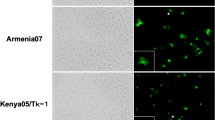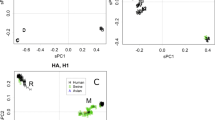Abstract
IT has been shown1 that when preparations of MEF 1 (type II) polio-virus (P. hominis) are exposed to heat at 50° C., there is a marked reduction in the rate of inactivation as the exposure time is increased (see Fig. 1). Bodian et al. 2 have suggested that such a phenomenon occurring during the inactivation of polio-virus with formaldehyde may be due to (1) protection of some virus particles by aggregation, or (2) the presence of inherently resistant particles, and concluded that there was no evidence to support the latter possibility. Since either of these possibilities may explain our results with heat as the inactivating agent, they formed the basis of further experiments.
This is a preview of subscription content, access via your institution
Access options
Subscribe to this journal
Receive 51 print issues and online access
$199.00 per year
only $3.90 per issue
Buy this article
- Purchase on Springer Link
- Instant access to full article PDF
Prices may be subject to local taxes which are calculated during checkout
Similar content being viewed by others
References
Stanley, N. F., Dorman, D. C., Ponsford, Joan, and Larkin, Maureen, Aust. J. Exp. Biol. and Med. Sci., Paper IV of series (in the press).
Bodian, D., et al., J. Amer. Med. Assoc., 159, 1444 (1955).
Stanley, N. F., Dorman, D. C., Ponsford, Joan, and Larkin, Maureen, Aust. J. Exp. Biol. Med. Sci., Paper II of series (in the press).
Author information
Authors and Affiliations
Rights and permissions
About this article
Cite this article
STANLEY, N., DORMAN, D., PONSFORD, J. et al. Isolation of a Heat-resistant Variant of Polio-virus. Nature 178, 413–414 (1956). https://doi.org/10.1038/178413b0
Issue Date:
DOI: https://doi.org/10.1038/178413b0
This article is cited by
-
The genetic relationship between thermostability of poliovirus and its in vivo response to cystine
Archiv f�r die gesamte Virusforschung (1960)
Comments
By submitting a comment you agree to abide by our Terms and Community Guidelines. If you find something abusive or that does not comply with our terms or guidelines please flag it as inappropriate.



